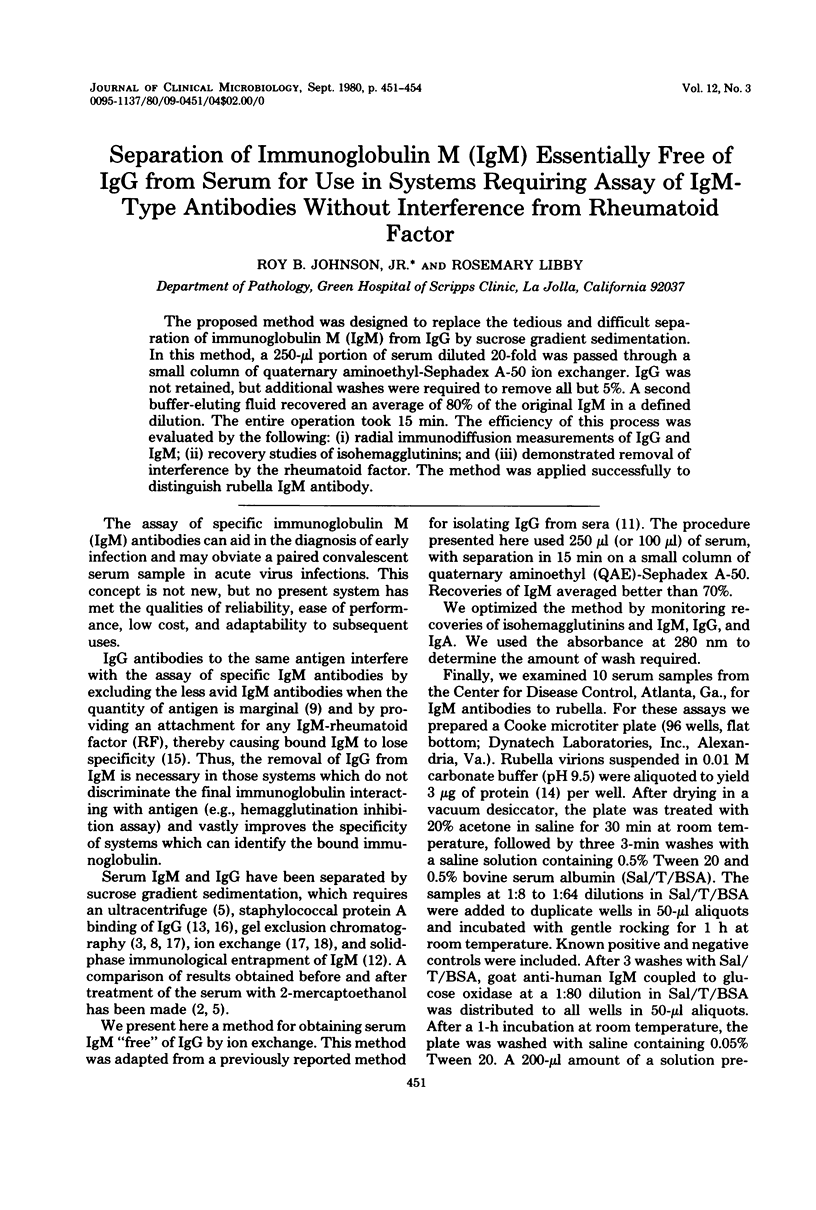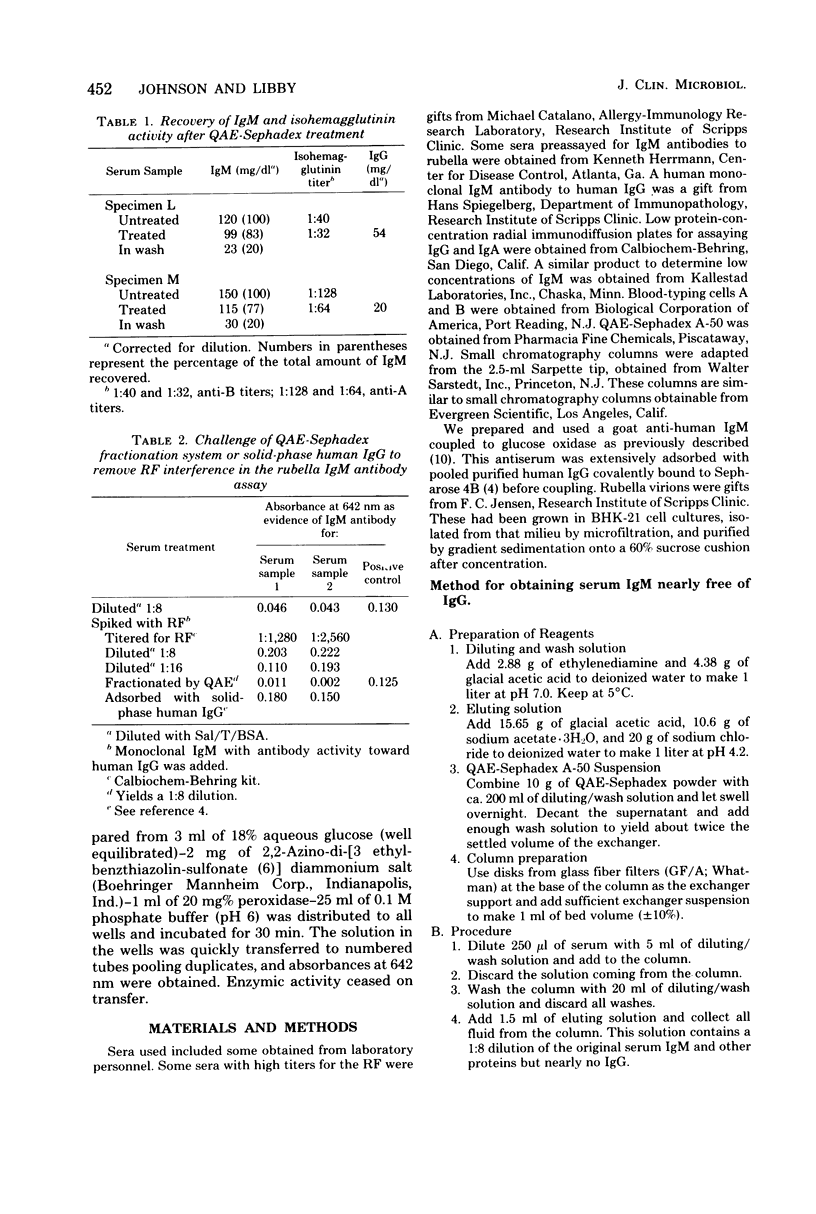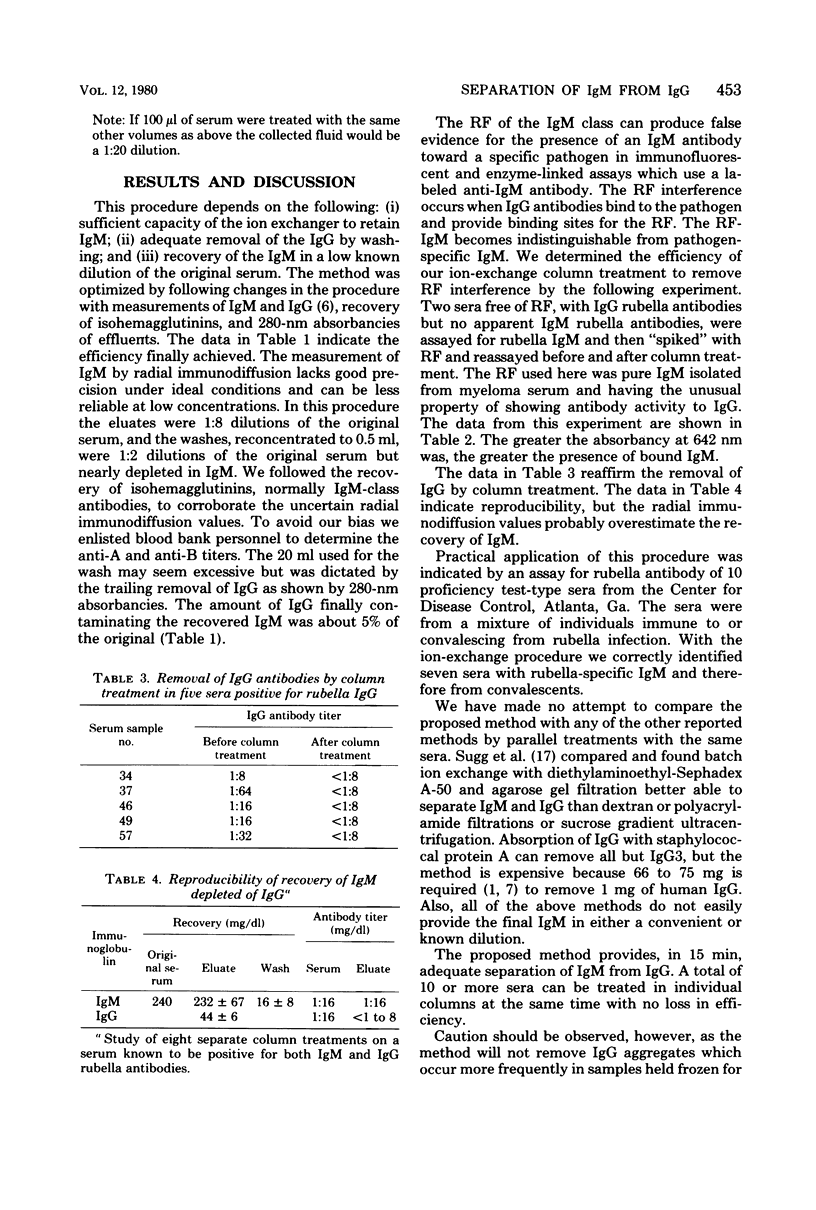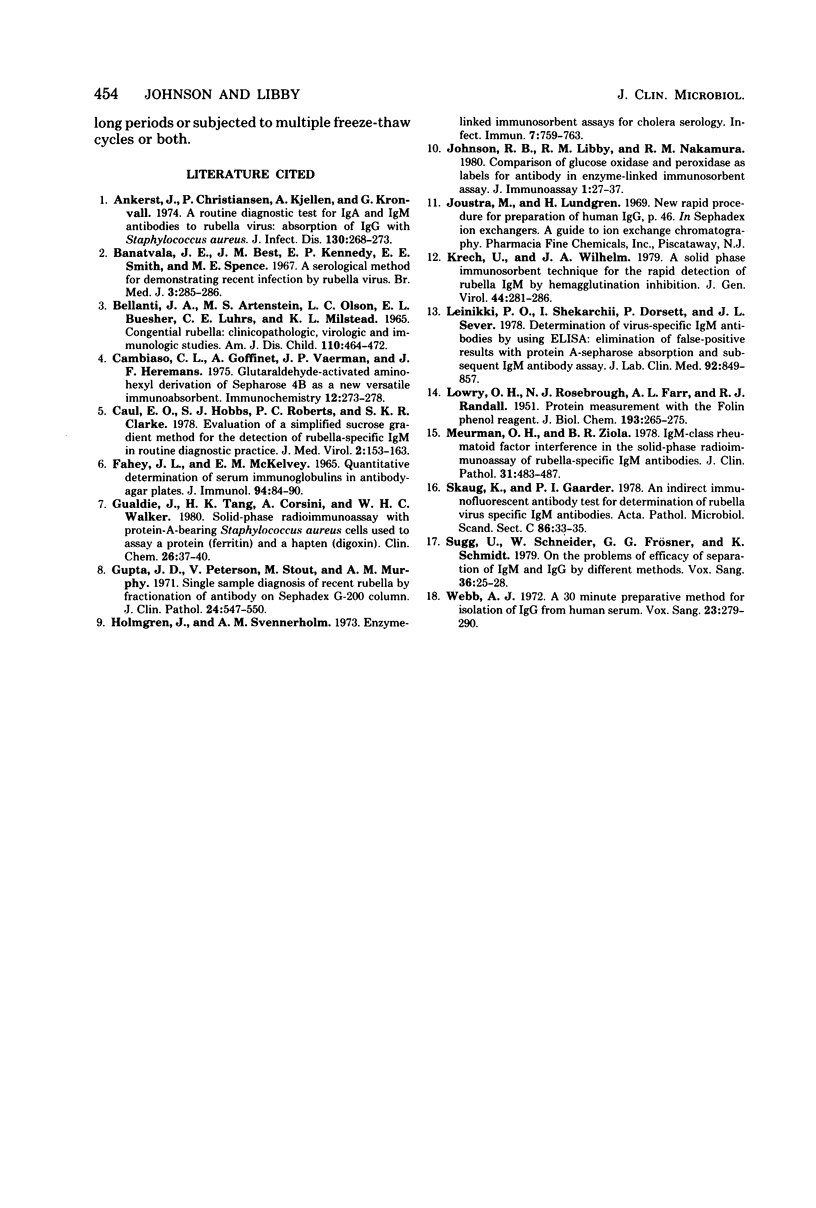Abstract
The proposed method was designed to replace the tedious and difficult separation of immunoglobulin M (IgM) from IgG by sucrose gradient sedimentation. In this method, a 250-microliter portion of serum diluted 20-fold was passed through a small column of quaternary aminoethyl-Sephadex A-50 ion exchanger. IgG was not retained, but additional washes were required to remove all but 5%. A second buffer-eluting fluid recovered an average of 80% of the original IgM in a defined dilution. The entire operation took 15 min. The efficiency of this process was evaluated by the following: (i) radial immunodiffusion measurements of IgG and IgM; (ii) recovery studies of isohemagglutinins; and (iii) demonstrated removal of interference by the rheumatoid factor. The method was applied successfully to distinguish rubella IgM antibody.
Full text
PDF



Selected References
These references are in PubMed. This may not be the complete list of references from this article.
- Ankerst J., Christensen P., Kjellén L., Kronvall G. A rountine diagnostic test for IgA and IgM antibodies to rubella virus: absorption of IgG with Staphylococcus aureus. J Infect Dis. 1974 Sep;130(3):268–273. doi: 10.1093/infdis/130.3.268. [DOI] [PubMed] [Google Scholar]
- Banatvala J. E., Best J. M., Kennedy E. A., Smith E. E., Spence M. E. A serological method for demonstrating recent infection by rubella virus. Br Med J. 1967 Jul 29;3(5560):285–286. doi: 10.1136/bmj.3.5560.285. [DOI] [PMC free article] [PubMed] [Google Scholar]
- Bellanti J. A., Artenstein M. S., Olson L. C., Buescher E. L., Luhrs C. E., Milstead K. L. Congenital rubella. Clinicopathologic, virologic, and immunologic studies. Am J Dis Child. 1965 Oct;110(4):464–472. doi: 10.1001/archpedi.1965.02090030484020. [DOI] [PubMed] [Google Scholar]
- Cambiaso C. L., Goffinet A., Vaerman J. P., Heremans J. F. Glutaraldehyde-activated aminohexyl- derivative of Sepharose 4B as a new verstile immunoabsorbent. Immunochemistry. 1975 Apr;12(4):273–278. doi: 10.1016/0019-2791(75)90175-5. [DOI] [PubMed] [Google Scholar]
- Caul E. O., Hobbs S. J., Roberts P. C., Clarke S. K. Evaluation of a simplified sucrose gradient method for the detection of rubella-specific IgM in routine diagnostic practice. J Med Virol. 1978;2(2):153–163. doi: 10.1002/jmv.1890020210. [DOI] [PubMed] [Google Scholar]
- FAHEY J. L., MCKELVEY E. M. QUANTITATIVE DETERMINATION OF SERUM IMMUNOGLOBULINS IN ANTIBODY-AGAR PLATES. J Immunol. 1965 Jan;94:84–90. [PubMed] [Google Scholar]
- Gauldie J., Tang H. K., Corsini A., Walker W. H. Solid-phase radioimmunoassay with protein-A-bearing Staphylococcus aureus cells used to assay a protein (ferritin) and a hapten (digoxin). Clin Chem. 1980 Jan;26(1):37–40. [PubMed] [Google Scholar]
- Gupta J. D., Peterson V., Stout M., Murphy A. M. Single-sample diagnosis of recent rubella by fractionation of antibody on Sephadex G-200 column. J Clin Pathol. 1971 Sep;24(6):547–550. doi: 10.1136/jcp.24.6.547. [DOI] [PMC free article] [PubMed] [Google Scholar]
- Holmgren J., Svennerholm A. M. Enzyme-linked immunosorbent assays for cholera serology. Infect Immun. 1973 May;7(5):759–763. doi: 10.1128/iai.7.5.759-763.1973. [DOI] [PMC free article] [PubMed] [Google Scholar]
- Johnson R. B., Jr, Libby R. M., Nakamura R. M. Comparison of glucose oxidase and peroxidase as labels for antibody in enzyme-linked immunosorbent assay. J Immunoassay. 1980;1(1):27–37. doi: 10.1080/01971528008055774. [DOI] [PubMed] [Google Scholar]
- Krech U., Wilhelm J. A. A solid-phase immunosorbent technique for the rapid detection of rubella IgM by haemagglutination inhibition. J Gen Virol. 1979 Aug;44(2):281–286. doi: 10.1099/0022-1317-44-2-281. [DOI] [PubMed] [Google Scholar]
- LOWRY O. H., ROSEBROUGH N. J., FARR A. L., RANDALL R. J. Protein measurement with the Folin phenol reagent. J Biol Chem. 1951 Nov;193(1):265–275. [PubMed] [Google Scholar]
- Leinikki P. O., Shekarchi I., Dorsett P., Sever J. L. Determination of virus-specific IgM antibodies by using ELISA: elimination of false-positive results with protein A-Sepharose absorption and subsequent IgM antibody assay. J Lab Clin Med. 1978 Dec;92(6):849–857. [PubMed] [Google Scholar]
- Meurman O. H., Ziola B. R. IgM-class rheumatoid factor interference in the solid-phase radioimmunoassay of rubella-specific IgM antibodies. J Clin Pathol. 1978 May;31(5):483–487. doi: 10.1136/jcp.31.5.483. [DOI] [PMC free article] [PubMed] [Google Scholar]
- Skaug K., Gaarder P. I. An indirect immunofluorescent antibody test for determination of Rubella virus specific IgM antibodies. Elimination of secondary IgM rheumatoid factor staining after absorption of serum IgG with Staphylococcal protein A. Acta Pathol Microbiol Scand C. 1978 Feb;86(1):33–35. doi: 10.1111/j.1699-0463.1978.tb02554.x. [DOI] [PubMed] [Google Scholar]
- Sugg U., Schneider W., Frösner G. G., Schmidt K. On the problems of efficacy of separation of IgM and IgG by different methods. Vox Sang. 1979;36(1):25–28. doi: 10.1111/j.1423-0410.1979.tb04394.x. [DOI] [PubMed] [Google Scholar]
- Webb A. J. A 30-minute preparative method for isolation of IgG from human serum. Vox Sang. 1972;23(4):279–290. doi: 10.1111/j.1423-0410.1972.tb03462.x. [DOI] [PubMed] [Google Scholar]


